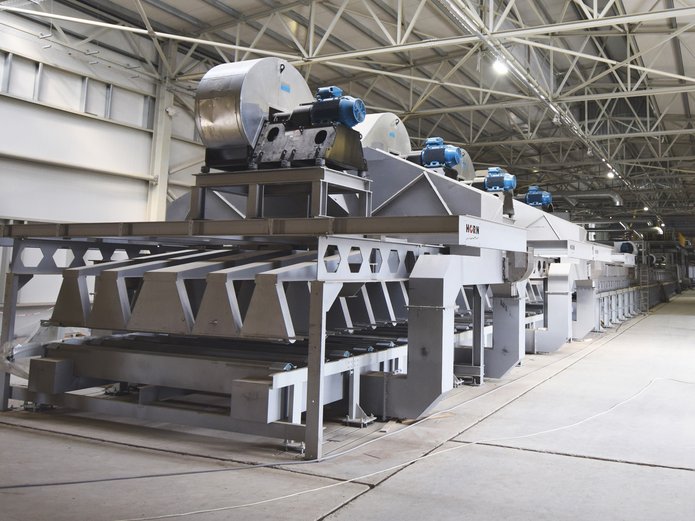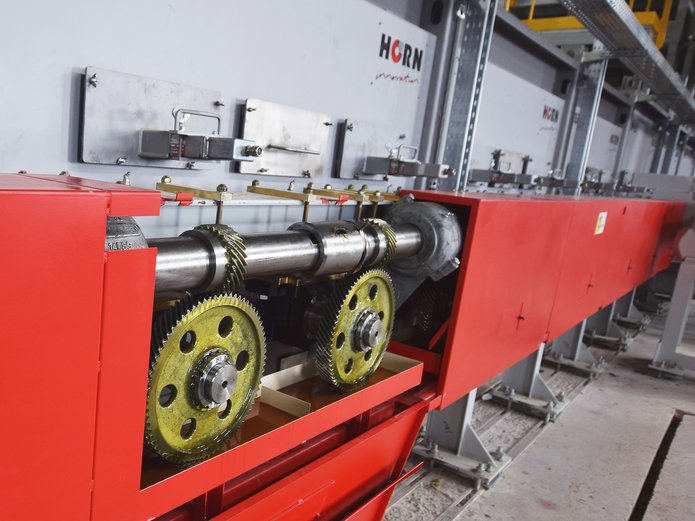Lehr is an essential part of the glass production line used for cooling the glass ribbon after forming. A uniform controlled cooling from about 600 °C to about 60 °C ensures an optimal distribution of residual stresses in the glass ribbon and thus facilitates easy glass workmanship.
During the cooling process mechanical stresses (lateral and plane) develop within the glass. These stresses can be permanent or temporary. Permanent stresses are formed at temperatures of 470 – 480 °C, whereas temporary stresses arise at lower temperatures. Excessive residual stress at the edges of the glass ribbon makes it difficult to cut the glass. On the other hand, if the residual stress at the edges is too low, then the glass becomes brittle and the edges will not cut cleanly.
We have utilised all of our experience gained over the recent years developing our Float Annealing Lehr. Since we know practically every weak point of the lehr, we’ve been working hard to improve on these and now present you the result.
Float Annealing Lehr is equipped with a drive mechanism that sets the rollers in motion. The rollers pull the glass ribbon from the tin bath into the lehr. The speed of the rollers depends on the glass thickness and can be monitored and controlled locally on site or remotely from the control room. PCs with appropriate software are readily available for this.
Float Annealing Lehr is divided into several zones:
In the insulated zones the glass ribbon is brought to the desired temperature by indirect cooling. These zones have different types of equipment: stainless steel and carbon steel heat exchangers as well as fans for continuous cooling, heating elements for edge heating, thermocouples and optical pyrometers for monitoring and controlling the cooling process. The heating elements’ area of application can be adjusted as required.
The thickness of the glass ribbon is measured in real-time at the lehr entrance (hot zone). For this purpose, 5 measuring points across the width of the glass ribbon are considered. Based on the measured thickness profile, the ribbon forming process can be controlled in near real-time. Such thickness measurement has a number of advantages, such as quick transition between glass thicknesses and improved product quality.
These zones provide a possibility to remove glass cullet.
In the non-insulated zones, the glass ribbon is cooled with preheated exhaust air and further with a mix of hot and fresh air. The air flow is generated by fans and distributed via the air nozzles located above and below the glass ribbon. The air flow can be adjusted manually as required. The proportion of hot exhaust air is regulated automatically depending on the required temperature.
HORN® manufactures the full range of equipment for the hot end in-house. This minimises the number of critical interfaces and eliminates potential problems that can arise when implementing adjustments made by different suppliers. Clarification and coordination of adjustments can cost a lot of time and money, and there’s a risk that some issues will still remain unsolved.
HORN® also produces all crucial lehr components in its own workshop in Plössberg. This means quality made in Germany.
COOKIES
We use cookies to make it easier to use and to further improve our service.
If you have given us your consent, you can revoke it at any time in the data protection declaration.
COOKIES
Necessary
Necessary cookies help make a website usable by enabling basic functions such as page navigation and access to secure areas of the website. The website cannot function properly without these cookies.
C3 Cookie
| Name | Provider | Purpose | Expiration | Type |
|---|---|---|---|---|
| c3kie | hornglass.com | Saves the consent status of the user whether the cookie window should be displayed. | 180 days | HTTP Cookie |
Technical
Technichal cookies help to improve the user experience of the website. New functionalities will be enabled.
YouTube
| Name | Provider | Purpose | Expiration | Type |
|---|---|---|---|---|
| yt-player-headers-readable | YouTube | Used to determine the optimal video quality based on the visitor's device and network settings. | Persistent | HTML Local Storage |
| VISITOR_INFO1_LIVE | YouTube | Tries to estimate the range of users on pages with built-in YouTube videos. | 179 days | HTTP Cookie |
| YSC | YouTube | Registers a unique ID to keep statistics on which videos from YouTube the user has seen. | Session | HTTP Cookie |
| yt.innertube::nextId | YouTube | Registers a unique ID to keep statistics on which videos from YouTube the user has seen. | Persistent | HTML Local Storage |
| yt.innertube::requests | YouTube | Registers a unique ID to keep statistics on which videos from YouTube the user has seen. | Persistent | HTML Local Storage |
| ytidb::LAST_RESULT_ENTRY_KEY | YouTube | Saves the user's video player settings with embedded YouTube video. | Persistent | HTML Local Storage |
| yt-remote-cast-available | YouTube | Saves the user's video player settings with embedded YouTube video. | Session | HTML Local Storage |
| yt-remote-cast-installed | YouTube | Saves the user's video player settings with embedded YouTube video. | Session | HTML Local Storage |
| yt-remote-connected-devices | YouTube | Saves the user's video player settings with embedded YouTube video. | Persistent | HTML Local Storage |
| yt-remote-device-id | YouTube | Saves the user's video player settings with embedded YouTube video. | Persistent | HTML Local Storage |
| yt-remote-fast-check-period | YouTube | Saves the user's video player settings with embedded YouTube video. | Session | HTML Local Storage |
| yt-remote-session-app | YouTube | Saves the user's video player settings with embedded YouTube video. | Session | HTML Local Storage |
| yt-remote-session-name | YouTube | Saves the user's video player settings with embedded YouTube video. | Session | HTML Local Storage |
Advertisement
Advertisement cookies allow our advertising partners to show you ads that fit your interests.
TikTok
| Name | Provider | Purpose | Expiration | Type |
|---|---|---|---|---|
| _ttp | TikTok | Used to store a unique user ID. | 1 year | HTTP Cookie |
| Name | Provider | Purpose | Expiration | Type |
|---|---|---|---|---|
| _fbp | Used to store and track visits to websites. | 3 months | HTTP Cookie |
Statistics
Statistics cookies help website owners understand how visitors interact with websites by collecting and reporting information anonymously.
Google Tag Manager
| Name | Provider | Purpose | Expiration | Type |
|---|---|---|---|---|
| _ga | Google Tag Manager | Registers a unique ID that is used to generate statistical data on how the visitor uses the website. | 2 years | HTTP Cookie |
| _ga_ | Google Tag Manager | Collects data on how often a user visited a website, as well as data on the first and last visit. Used by Google Analytics. | 2 years | HTTP Cookie |
Microsoft Clarity
| Name | Provider | Purpose | Expiration | Type |
|---|---|---|---|---|
| _clck | Microsoft | Persists the Clarity User ID and preferences, unique to that site is attributed to the same user ID. | 1 year | HTTP Cookie |
| _clsk | Microsoft | Connects multiple page views by a user into a single Clarity session recording. | 1 year | HTTP Cookie |
| CLID | Microsoft | Identifies the first-time Clarity saw this user on any site using Clarity. | 1 year | HTTP Cookie |
| ANONCHK | Microsoft | Indicates whether MUID is transferred to ANID, a cookie used for advertising. Clarity doesn't use ANID and so this is always set to 0. | 1 year | HTTP Cookie |
| MR | Microsoft | Indicates whether to refresh MUID. | 1 year | HTTP Cookie |
| MUID | Microsoft | Identifies unique web browsers visiting Microsoft sites. These cookies are used for advertising, site analytics, and other operational purposes. | 1 year | HTTP Cookie |
| SM | Microsoft | Used in synchronizing the MUID across Microsoft domains. | 1 year | HTTP Cookie |

